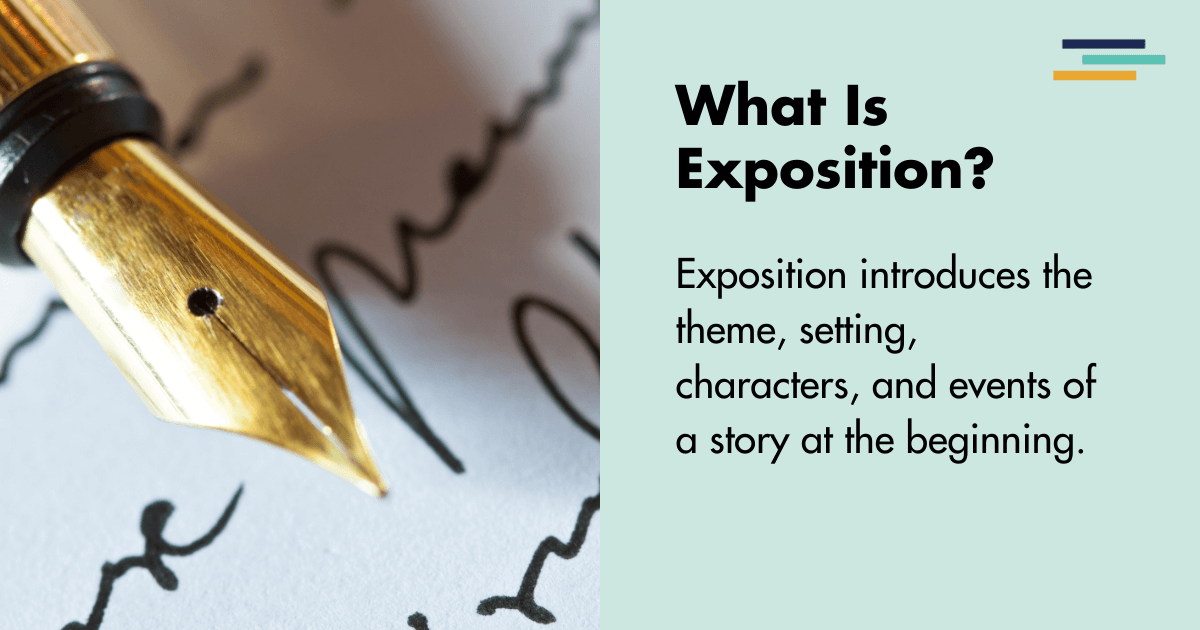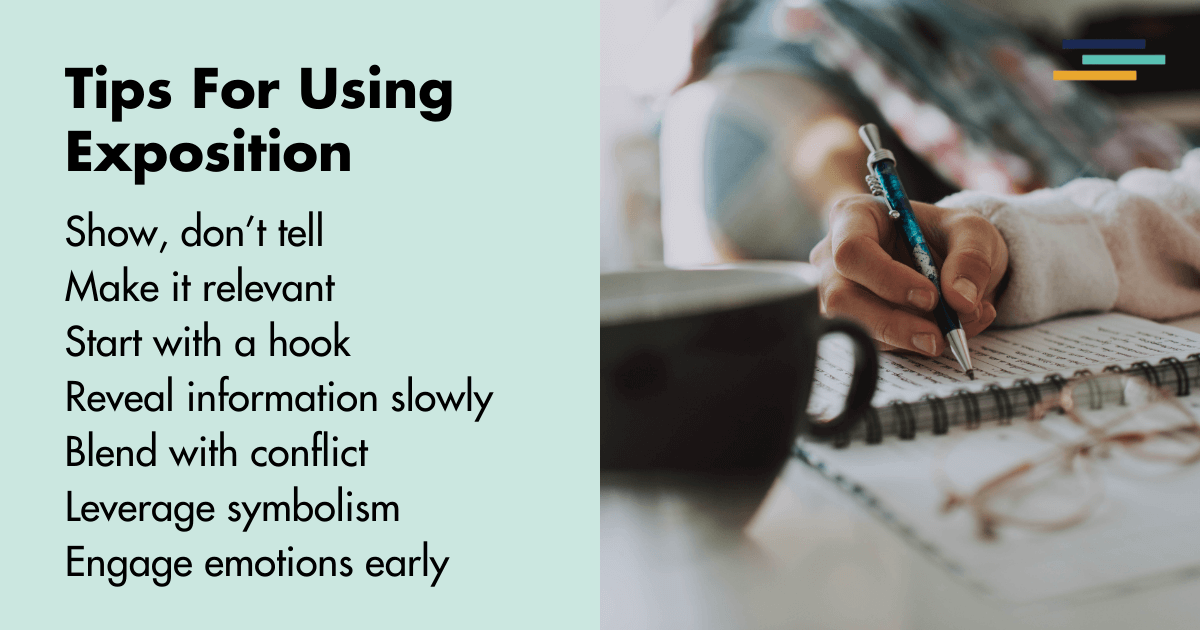
I’ll bet you’ve heard the advice, “Show, don’t tell,” and this advice is grand, except for when it comes to one tool you should add to your writerly toolkit.
Yep, you guessed it, folks.
I’m talking about exposition.
Understanding exposition is essential for any writer.
Exposition lays the groundwork for a story, providing crucial background information that sets the stage for the entire novel.
In this article, you’ll discover the definition of exposition, its history and origin, and its specific role within a story. You’ll also examine various examples of our good old friend exposition from well-known books to illustrate how it functions in real life.
Finally, you’ll learn a bunch of practical tips for effectively using exposition in your writing to create engaging and well-rounded stories.
Let’s dive in and uncover the importance of exposition in literature.
Exposition Definition Literature
Dictionary Definition:
“Exposition in literature refers to the part of a story that sets the stage for the drama to follow.”
It can occur at the start of your story (remember the start of Divergent by Veronica Roth, where the author masterfully weaves in all the information about how the factions work while Tris goes about day-to-day life?), or it can happen later on in the story (in the same book, we learn about the history of Tris’s version of Chicago when one of the faction leaders gives a speech to the potential Initiates).
Note: It is most common at the start of stories, because you need less exposition as a story
goes on.
Exposition also introduces the theme, setting, characters, and circumstances at the story’s beginning. Exposition is one of four rhetorical modes of discourse, along with argumentation, description, and narration (but those are articles for another time).
Exposition Meaning
The term exposition comes from the Latin word “expositio,” which means “a showing forth.”
Its use dates back to ancient Greek drama, where it was a crucial element in plays.
Aristotle waxed lyrical about the topic of exposition in his famous work, “Poetics,” highlighting its role in providing necessary background information to understand the plot. Over the centuries, the application of exposition has developed, but its core purpose remains the same.
Writers use exposition to inform the audience about the world they are about to enter. If you don’t include exposition at the start of your novel, it’s hard to ground your reader in the events of the story, and they will feel lost.

What Is the Exposition of a Story?
In modern storytelling, exposition is the initial section of a narrative where the writer introduces essential background information to the audience. And, if you pay close attention, you’ll see that it exists to introduce the three Fictionary Supergroups:
- Character
- Plot
- Setting
So, exposition includes the setting (time and place), the characters, and the initial circumstances (plot). It often answers fundamental questions like, “Who are the characters?”, “Where and when is the story taking place?”, and “What’s the initial (plot) situation?”
This setup is crucial as it provides some much-needed context for the audience to understand and engage with your story.
Exposition Examples
The Midnight Library by Matt Haig (2020)
In The Midnight Library, the exposition begins by introducing Nora Seed, a woman who feels trapped in a life filled with regrets and missed opportunities. The narrative sets the stage by exploring her personal struggles, including her feelings of depression and isolation.
Haig provides background on Nora’s past decisions, relationships, and her current state of despair, which eventually leads her to the Midnight Library, a magical place between life and death where she can explore different versions of her life.
The Vanishing Half by Brit Bennett (2020)
The Vanishing Half opens with the story of the Vignes twins, Desiree and Stella, who grow up in the small, southern black community of Mallard. Bennett provides a rich background of the town’s history, including its founding and the cultural importance of skin color within the community.
This initial setup introduces the reader to the twins’ early lives and the significant events that shape their identities and choices, setting the stage for the complex narrative about family, identity, and race.
Where the Crawdads Sing by Delia Owens (2018)
In Where the Crawdads Sing, the exposition introduces the reader to the marshlands of North Carolina and the mysterious “Marsh Girl,” Kya Clark. Owens provides a vivid description of the setting and Kya’s solitary life after being abandoned by her family.
The early chapters explore her childhood struggles, the natural world around her, and the small town’s prejudices, establishing a strong sense of place and character that drives the narrative.
An American Marriage by Tayari Jones (2018)
An American Marriage begins by introducing Celestial and Roy, a young African American couple living in Atlanta. Jones provides background on their relationship, career aspirations, and family dynamics.
The exposition delves into their personal histories and the societal pressures they face, setting the stage for the central conflict that arises when Roy is wrongfully imprisoned. This background information is crucial for understanding the emotional and psychological impact of the event on their marriage.
The Night Circus by Erin Morgenstern (2019)
The Night Circus opens with a description of the mysterious and enchanting Le Cirque des Rêves, a circus that appears without warning and operates only at night. Morgenstern introduces the reader to the key characters, Celia and Marco, who are bound by a magical competition orchestrated by their mentors.
The exposition provides insights into the circus’s creation, the magical rules governing it, and the backgrounds of the protagonists, setting the stage for the unfolding magical and romantic drama.

Tips for Using Exposition in Literature
- Integrate Exposition Seamlessly: Avoid info-dumping. Integrate exposition naturally into dialogue, actions, and thoughts of characters.
- Show, Don’t Tell: Show the exposition through character actions and interactions rather than lengthy descriptions.
- Make It Relevant: Ensure that all background information provided applies to the story and contributes to character development or plot progression.
- Use Flashbacks Sparingly: Flashbacks can be an effective way to provide exposition, but use them sparingly to avoid disrupting the narrative flow.
- Start with a Hook: Even in the exposition, start with something intriguing or interesting to engage readers.
- Reveal Information Gradually: Don’t overwhelm readers with too much information at once. Reveal background details gradually as the story progresses.
- Use Characters’ Perspectives: Use the perspectives of different characters to provide varied insights into the story’s background and setting.
- Keep It Short: The exposition should be concise and to the point. Provide just enough information to understand the story’s context without dragging the pace.
- Blend with Conflict: Introduce elements of conflict early on within the exposition to keep the readers interested and engaged.
- Use Descriptive Language: Employ vivid and precise descriptions to make the setting and characters come alive for the reader.
- Avoid Clichés: Steer clear of overused setups or backgrounds. Strive for originality in how you present the exposition.
- Include Sensory Details: Engage the readers’ senses by incorporating sensory details into your exposition.
- Create Immediate Stakes: Present a sense of urgency or stakes early on to hook the reader.
- Leverage Symbolism: Use symbolic elements in the exposition to foreshadow future events or themes.
- Develop Unique Voices: Ensure characters introduced in the exposition have distinct and memorable voices.
- Use Setting to Reflect Theme: Let the setting in your exposition hint at or reflect the overarching themes of your story.
- Anchor in a Specific Time: Clearly establish the time period in your exposition to help ground the story.
- Foreshadow Future Events: Use subtle hints or clues in the exposition to foreshadow future plot developments.
- Engage Emotions Early: Tap into the readers’ emotions from the start to build a strong connection.
- Introduce Key Objects or Places: Mention significant objects or locations early in the exposition that will be important later in the story.
Exposition is a vital part of storytelling that provides the background information for readers to understand and engage with your story, your characters, and your world. By integrating exposition seamlessly, making it relevant, and revealing it gradually, you can create an interesting foundation for your stories.
And finally, always remember that story comes first. Focus on:
- Creating engaging characters
- Penning interesting plots
- Structuring solid settings
A tool like Fictionary helps you turn your draft into an interesting story readers love. So, with the right amount of exposition and a strong narrative foundation, your writing can truly shine.


